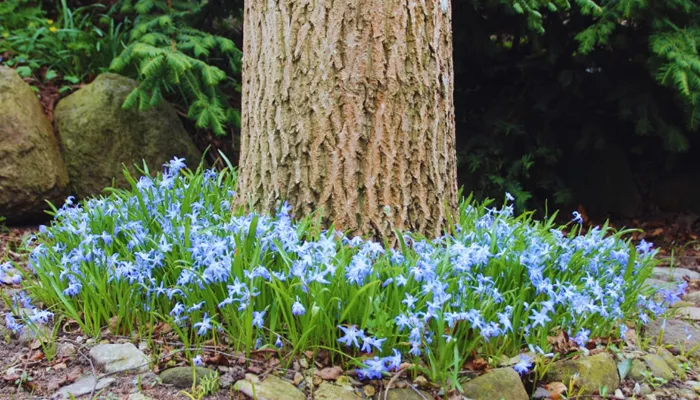Flower beds around trees can transform your garden, adding vibrant colors and emphasizing the natural beauty of the tree. Here are eight inventive ideas to create eye-catching flower beds around your trees.
1. Circular Raised Flower Bed Building a raised flower bed around a tree is a simple yet effective method. Construct a circular enclosure using natural stones, bricks, or wooden borders. Ensure the bed is raised 6-12 inches above ground and fill it with nutrient-rich soil. Opt for shade-tolerant plants such as hostas, impatiens, or begonias, which thrive under the tree’s canopy.
2. Multi-Layered Flower Bed Create visual interest by planting flowers in tiers. Begin with low-growing ground covers like ivy, creeping thyme, or sedum. Add mid-height plants such as astilbe or ferns, and finish with taller varieties like foxgloves or hydrangeas around the outer edge. This layered approach results in a lush and dynamic flower bed.
3. Rock Garden Flower Bed Incorporate rocks or pebbles into your flower bed for a natural, rugged look. Arrange a mix of large stones and small pebbles around the tree in an organic pattern. Plant hardy, drought-resistant flowers like lavender, echinacea, or daylilies to complement the earthy tones of the rocks.
4. Colourful Perennial Flower Bed Perennials, which return each year, are ideal for flower beds around trees. Select a variety of colors and blooming times for continuous interest. Flowers such as black-eyed Susans, bleeding hearts, and columbines offer vibrant, long-lasting beauty.
5. Woodland-Style Flower Bed For a natural look, design a woodland-style flower bed with native wildflowers. Include plants like trilliums, woodland phlox, and Solomon’s seal. Enhance the woodland theme with moss, ferns, and ground covers, creating a seamless blend with the tree.
6. Herb and Flower Combination Bed Combine beauty with practicality by planting herbs alongside flowers. Herbs like thyme, mint, and oregano pair well with blooms such as marigolds or pansies. This blend not only adds aesthetic appeal but also provides fresh herbs for culinary use.
7. Geometric Flower Bed For a contemporary appearance, opt for a geometric flower bed. Instead of traditional circular or freeform designs, use shapes like squares, triangles, or hexagons. Define the edges with materials like stone, wood, or metal, and arrange flowers in color blocks or stripes for a striking effect.
8. Seasonal Flower Bed Maintain year-round interest with a seasonal flower bed. Plant spring bulbs like tulips, daffodils, and crocuses. In summer, choose shade-loving annuals such as impatiens or begonias. Transition to fall with asters or mums, and consider winter-friendly plants like hellebores for ongoing appeal.
Related topics:
- How Orchids Use a Simple Trick to Grow New Flower Spikes in Just Days
- Enigmatic Plant: Spiky Flowering Species
- Dahlias Shine Bright as Gardens Fade


